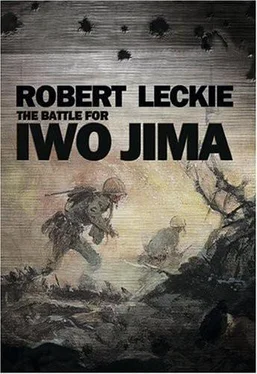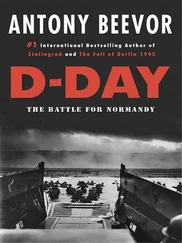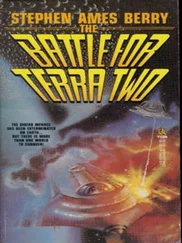General Erskine’s solution was a surprise predawn attack without artillery. His division still held the center, and its mission was to crack straight through to the other end of the island. When that was accomplished, the Japanese would be split in two. Then the 4 Division on the right would clean out all resistance in its area, while the 3 would join the 5 in mopping up the left.
Blocking the 3 Division’s path to the sea was a height called 362C. This hill covered other Japanese positions on the right. (All of these enemy positions were located on the high ground of Motoyama Plateau.) So General Erskine ordered one battalion to take Hill 362C by surprise attack, while two other battalions slipped into position to attack the enemy emplacements on the right. (All of these enemy positions were located on the high ground of Motoyama Plateau.) So General Erskine ordered one battalion to take Hill 362C by surprise attack, while two other battalions slipped into position to attack the enemy emplacements on the right. Once Hill 362C was taken and its guns silenced, the two battalions on the right could begin to attack without fear of flanking fire.
At five o’clock in the morning, with a whistling wind hurling cold rain in their faces, the Marines moved out. Not a shot was fired. Not a hand was raised against them. The two battalions in the center and right reported having moved 200 yards. On the left at Hill 362C, the Marines came upon the Japanese asleep in their trenches and killed all of them. Jubilant, they reported that they had taken Hill 362C.
But they had not!
By mistake they had climbed and conquered Hill 331. At daylight Hill 362C began to pour fire onto the center and right battalions, pinning them down. Now a desperate battle began. Throughout the day the trapped Marine battalions fought back. But their number was steadily whittled.
In the center, 200-man companies were down to barely more than 10-man squads. By nightfall, Lieutenant Wilcie O’Bannon commanded fewer than 10 men in F Company. They were huddled on a mound 300 yards inside the Japanese strongpoint. After O’Bannon’s radio fell silent, Lieutenant Colonel Robert Cushman ordered tanks to the rescue. Thirty-six hours after the predawn attack began, the tanks rumbled up to the mound where O’Bannon lay with just four men. Straddling the Marines, the tankers reached through the escape hatches in the bellies of the tanks and dragged them safely inside. Company E under Captain Maynard Schmidt in the same sector fared only slightly better: it had seven survivors.
To the right, other companies were being cut up by enemy fire. Here Lieutenant John Leims risked death three times to save his Marines. He crawled 400 yards through enemy fire to lay communications wire from his cut-off company to battalion headquarters. Then he withdrew the company, after which he twice crawled back to his abandoned position to rescue wounded Marines there. For this, Lieutenant Leims received the Medal of Honor.
So did Lieutenant Jack Lummus, who was fighting with the 5 Division just a little to the left of the embattled 3. Lieutenant Lummus was a former All-America end at Baylor University. Now, instead of carrying him on a touchdown run, his powerful legs were carrying him out in front of his pinned-down company. A grenade knocked Lummus sprawling, but he jumped up and rushed on, knocking out a gun emplacement. Another grenade downed him, shattering his shoulder. He arose and dashed forward, again destroying an enemy position and killing its defenders.
Lieutenant Lummus then turned and called to his men to follow him. Inspired by his courage and leadership, they arose and charged, pouring through the enemy network. Then a land mine exploded with a roar and a shower of dirt. When the smoke cleared Jack Lummus appeared to be standing in a hole. The explosion had torn off both legs and he was standing on the bloody stumps, still urging his men forward.
They ran to him sobbing. Some Marines wanted to end his agony for him, but he motioned them forward. As they went, their tears turned to rage and they killed and blasted all before them. At the end of the day they were on a ridge over looking the sea.
To their rear, Jack Lummus lay in the division hospital. Pint after pint of blood was fed into his veins. He received 18 pints in all, but the doctors and Lummus knew that it was hopeless. Yet, as the lieutenant’s immense vitality slowly left him, his gaiety remained. “Doc,” he said at the end, “it looks like the New York Giants have lost a darn good end.” With his remaining strength he smiled, and then he died.
So it went throughout that tragic March 7. In spite of all their losses, however, the Marines had not suffered disaster. In the 3 Division’s sector, the battalion that had taken the wrong hill finally fought forward to Hill 362C. In the center and on the right, the sector now known as “Cushman’s Pocket” still resisted hotly and eight more days of fighting would be required to subdue it. But, as company after company entered the battle, Japanese resistance on Motoyama Plateau waned and finally died. By nightfall of March 7, the valuable high ground of the plateau was in Marine hands, and the end was in sight.
The enemy also seemed to believe that the end was near. As on Suribachi to the south, the Japanese in the north had begun to kill themselves. On that bloody March 7, a hundred enemy soldiers who were holed up inside a ridge on the left flank blew themselves up. But they also took with them a good part of a company of Marines atop the ridge.
With nightfall of March 8 there came the second proof of Japanese despair: the banzai charge.
This one was led by Captain Inouye, who was still grieving over the loss of Suribachi. He wanted to recapture the volcano and to wreck the American aircraft parked on Airfield Number One. To do so he would have to break through the 4 Division on his left flank. In all, he gathered about 1,000 men of his naval force. Most of them had rifles or grenades, but some had only bamboo spears. Many more had wound explosives around their waists. These human bombs planned to hurl themselves against American equipment.
Just before midnight, they started south. They did not charge immediately. Instead they crawled stealthily forward, hoping to slip through the American lines. But the moment they were detected, they arose and with turkey-gobbler shrieks of “Banzai! Banzai!” they came swarming forward.
Up went the Marine flares. Down came the Navy’s star shells. In that flickering, ghastly, artificial light, Marine mortars crumped and thumped among the charging enemy. Marine machine-gun fire cut them down and popping rifles picked them off. The battle was very quickly over, although, as in most night battles, sporadic firing continued until dawn. Daylight disclosed 784 enemy dead. Although the Marines had lost 90 killed and 257 wounded, Captain Inouye’s banzai had been their biggest break so far.
That afternoon the Marines received the welcome news that the other end of the island had been reached. Under Lieutenant Paul Connally, a 28-man platoon from the 3 Division came to a high bluff. Looking down, they saw the ocean. Scrambling below in full view of dumfounded enemy gunners, they waded into the water and scooped it up to wash the grit of Iwo from their faces. Some men took off their shoes to bathe their feet. But then the enemy gunners recovered from their surprise and began firing. Men fell, wounded, and the patrol withdrew.
Some of the men returned, however, to fill a canteen with salt water to prove that the 3 Division had been the first to traverse the length of Iwo. The canteen was sent back to General Erskine with the warning: “For inspection, not consumption.”
Eighteen days after the battle for Iwo Jima began, the island had been traversed. What was left of the defenders had been cut in two, and now the pieces had to be destroyed.
Читать дальше











